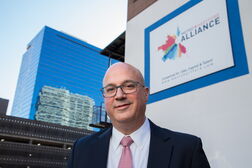
Processing Your Payment
Please do not leave this page until complete. This can take a few moments.
-
News
-
Editions
-
- Lists
-
Viewpoints
-
HBJ Events
-
Event Info
- 2024 Economic Outlook Webinar Presented by: NBT Bank
- Best Places to Work in Connecticut 2024
- Top 25 Women In Business Awards 2024
- Connecticut's Family Business Awards 2024
- What's Your Story? A Small Business Giveaway 2024 Presented By: Torrington Savings Bank
- 40 Under Forty Awards 2024
- C-Suite and Lifetime Achievement Awards 2024
- Connecticut's Health Care Heroes Awards 2024
-
-
Business Calendar
-
Custom Content
- News
-
Editions
View Digital Editions
Biweekly Issues
- April 29, 2024
- April 15, 2024
- April 1, 2024
- March 18, 2024
- March 4, 2024
- February 19, 2024
- February 5, 2024
- January 22, 2024
- January 8, 2024
- + More
Special Editions
- Lists
- Viewpoints
-
HBJ Events
Event Info
- View all Events
- 2024 Economic Outlook Webinar Presented by: NBT Bank
- Best Places to Work in Connecticut 2024
- Top 25 Women In Business Awards 2024
- Connecticut's Family Business Awards 2024
- What's Your Story? A Small Business Giveaway 2024 Presented By: Torrington Savings Bank
- 40 Under Forty Awards 2024
- C-Suite and Lifetime Achievement Awards 2024
- Connecticut's Health Care Heroes Awards 2024
Award Honorees
- Business Calendar
- Custom Content
As pandemic restrictions lift, don’t expect Hartford employees to surge back to offices
 HBJ PHOTO | STEVE LASCHEVER
As the last of Connecticut’s pandemic restrictions are lifted, downtown Hartford offices remain relatively quiet, including at State House Square, which has temporarily shuttered its food court as a result. Property manager David Jakubowski said food vendors haven’t been charged rent during the closure.
HBJ PHOTO | STEVE LASCHEVER
As the last of Connecticut’s pandemic restrictions are lifted, downtown Hartford offices remain relatively quiet, including at State House Square, which has temporarily shuttered its food court as a result. Property manager David Jakubowski said food vendors haven’t been charged rent during the closure.
At State House Square, one of downtown Hartford’s major Class A office properties, David Jakubowski keeps a close eye on parking garage traffic reports, eager to see concrete signs of greater employee activity as COVID-19 vaccination rates rise.
However, Jakubowski, who manages the three-building property on behalf of its owners, has observed only a slight increase over the past few months. Inside, there’s still just a sliver of normal employee activity levels.
“We were hoping at this point we might have 25% of the normal population back to work,” Jakubowski said. “I see a few more people I haven’t seen in the last year, maybe one or two days a week.”
State House Square, which can accommodate 3,000 employees, is not alone.
Top officials at Shelbourne Global Solutions, Hartford’s largest office landlord, said their four downtown properties remain relatively quiet on any given weekday, though they estimate activity levels have climbed from 10% to somewhere between 15% and 20% in recent months.

“There’s definitely been an uptick,” said Shelbourne Managing Member Benjamin Schlossberg.
With Gov. Ned Lamont set to lift all remaining capacity restrictions on businesses May 19, it’s clear many employers don’t want to rush back-to-the-office decisions, as they continue to monitor the path of the coronavirus, vaccination rates and worker sentiment. At the same time many employers are investing in office safety upgrades and renovations, and weighing the logistics of a more hybrid work schedule moving forward.
While the situation is creating some jitters for commercial landlords, brokers and downtown Hartford boosters say there isn’t a sense of panic, but optimism that activity will pick up over the summer and increase further when the school year begins.
That matches with the return-to-work timelines of many large employers in downtown Hartford.
Companies recently contacted by Hartford Business Journal, including Aetna, Travelers, The Hartford and Bank of America, among others, say that despite Lamont’s decision to fully roll back business restrictions in mid-May, they are still targeting Labor Day as a key target for getting workers back to the office. (Lamont has told the state's 30,000 public workers they need to return to the office by July 1. However, state employees were allowed to work from home 50% of the time pre-pandemic, with a manager's permission.)
The reality is, employers still face a host of challenges with how to handle their workforce, including skittish employees who feel unsafe about coming back or who simply prefer remote work; decisions about office layouts, space needs and hybrid scheduling logistics; liability concerns; and potential employee resentment over some positions being allowed to work remotely when others are required to be present.
Short-, long-term planning
Joel Grieco, executive director at real estate brokerage Cushman & Wakefield, said he thinks employers are going to bring back a significant portion of their workers, just not instantaneously.

“Some companies are still making shorter-term decisions right now because they’re still solving for their workplace of the future,” Grieco said. “They’re still solving for just how hybrid they’re going to be.”
Jonathan Putnam, also a Cushman & Wakefield executive director, said some larger employers had already set plans in motion for fall return dates before Connecticut’s vaccine rollout accelerated more quickly than previously expected.
“I think we arrived at this place sooner than people might have thought,” Putnam said. “Now we’re just at the beginning of that change in the direction of the wind here.”
David Griggs, president and CEO of the MetroHartford Alliance, said he’s noted a more positive outlook among his member employers over the past month or so, likely due to the accelerated vaccine roll out, spring’s arrival, and the return of Yard Goats baseball and other events.
Still, companies realize that previously scheduled office homecomings have been delayed multiple times since the start of the pandemic last March, when many employers and workers figured — erroneously, as it turned out — that a brief, partial lockdown would wipe out the virus.
“When we left last March, we thought we were all leaving on a two-week snow day,” Griggs said. “I think what we’ve all learned is we have to be very flexible and fluid in what we plan for.”

For some, the fear of vaccine-beating COVID-19 variants lingers, and scientists say herd immunity against the virus, which would greatly slow its spread, is unlikely due to challenges in vaccinating a sufficient portion of the population, the New York Times reported this month. That means the virus may be something that must be managed for the foreseeable future, which has implications for physical workplaces and any other location humans gather in close proximity.
“I don’t think anyone has figured out the impact of that, what that means,” said Gary O’Connor, a Hartford-based commercial real estate and land use attorney at Pullman & Comley. “That may factor into a lot of decisions relating to the return to work and the office market in general.”
Whether corporate decision-makers are privately leaning toward a mandatory return, permanent remote work or a hybrid of the two, they are all feeling the pressure of competing interests and obligations, Griggs said.
The local economy is suffering from the lack of foot traffic downtown, and a non-vibrant center city could make it harder to recruit new hires; but current employees may also view an order to return to the office negatively.
“It’s a delicate dance,” Griggs said. “Our employers certainly feel the need from the city, small businesses and restaurants to have their people back. But at the same time, the number one thing is talent.”
Regaining pandemic lease losses
How quickly and to what extent employees return to Hartford has real stakes for the commercial real estate market.
While downtown’s office vacancy rate has only ticked up 1.9 percentage points during the pandemic — it currently stands at 18.9%, according to real estate brokerage CBRE — vacancies are seen as a lagging indicator due to long leasing cycles in the office market.
Michael Puzzo, a senior vice president at CBRE in Hartford, said those relatively small upticks don’t mean much for now. However, in the next few years, expiring leases of several major Hartford office tenants — which Puzzo declined to identify — could be of greater consequence, potentially resulting in a downsizing of several hundred thousand square feet in the city.
“The hits to the market that concern me are really more related to the large users of space that have the ability because of their scale to put large blocks of space back on the market,” Puzzo said. “The efforts to do more with less, which had gained steam prior to the pandemic, have accelerated.”
Nationally, Cushman & Wakefield predicts office vacancies will rise until the middle of 2022 before demand picks up again and vacancies begin to recede. That prediction hinges in part on forecasted employment growth, so whether Hartford follows a similar trajectory, or sees higher vacancies and a longer recovery could depend on job creation.
“Hartford may not come back like a jack-in-the-box, but if we come back like the tide coming in where it’s slow and steady and all of the sudden you look down and it’s around your ankles, that’s OK,” said Cushman’s Greico. “That’s what Hartford has traditionally been.”

At State House Square, Jakubowski said almost every office tenant with recent lease expirations opted to renew.
“We’re in a good spot with that,” he said, adding several larger tenants have renewals looming in 2023 and 2024.
Shelbourne, which owns or co-owns the Metro Center (350 Church St.), Stilts Building (20 Church St.), Gold Building and 100 Pearl, has collected nearly 100% of its owed office rents during the pandemic, but has seen some tenants with expiring leases in recent months opt to downsize their footprint or not renew at all, Schlossberg said. As a result, the company’s Hartford office properties, which total over 2 million square feet of space, have lost approximately 40,000 square feet of leased space during the pandemic.
“Hartford has been a very challenging market and we had made a lot of strides before the pandemic. We have to fight back now,” he said, adding that he expects the office market to begin to stabilize after Labor Day as companies start to return more workers to the office.
Shelbourne also said its team is talking to prospective tenants that could soon gobble up square footage that’s been vacated over the past year.
“Perhaps some of the more traditional mainstay businesses that we’ve been accustomed to in Hartford might be downsizing their footprint, but on the other end, we’re also seeing new industries and new businesses that are looking to expand and come into downtown,” said Michael Seidenfeld, Shelbourne’s chief operating officer. “There’s no way to know where the whole thing will shake itself out.”
“We’re not fixated on the past and we’re very nimble and flexible and we adapt,” he added.
Related Content

2022 Giving Guide
This special edition informs and connects businesses with nonprofit organizations that are aligned with what they care about. Each nonprofit profile provides a crisp snapshot of the organization’s mission, goals, area of service, giving and volunteer opportunities and board leadership.
Learn more
Subscribe
Hartford Business Journal provides the top coverage of news, trends, data, politics and personalities of the area’s business community. Get the news and information you need from the award-winning writers at HBJ. Don’t miss out - subscribe today.
Subscribe
2024 Book of Lists
Delivering Vital Marketplace Content and Context to Senior Decision Makers Throughout Greater Hartford and the State ... All Year Long!
Read Here-
2022 Giving Guide
This special edition informs and connects businesses with nonprofit organizations that are aligned with what they care about. Each nonprofit profile provides a crisp snapshot of the organization’s mission, goals, area of service, giving and volunteer opportunities and board leadership.
-
Subscribe
Hartford Business Journal provides the top coverage of news, trends, data, politics and personalities of the area’s business community. Get the news and information you need from the award-winning writers at HBJ. Don’t miss out - subscribe today.
-
2024 Book of Lists
Delivering Vital Marketplace Content and Context to Senior Decision Makers Throughout Greater Hartford and the State ... All Year Long!
ABOUT
ADVERTISE
NEW ENGLAND BUSINESS MEDIA SITES
No articles left
Get access now
In order to use this feature, we need some information from you. You can also login or register for a free account.
By clicking submit you are agreeing to our cookie usage and Privacy Policy
Already have an account? Login
Already have an account? Login
Want to create an account? Register
Get access now
In order to use this feature, we need some information from you. You can also login or register for a free account.
By clicking submit you are agreeing to our cookie usage and Privacy Policy
Already have an account? Login
Already have an account? Login
Want to create an account? Register









0 Comments